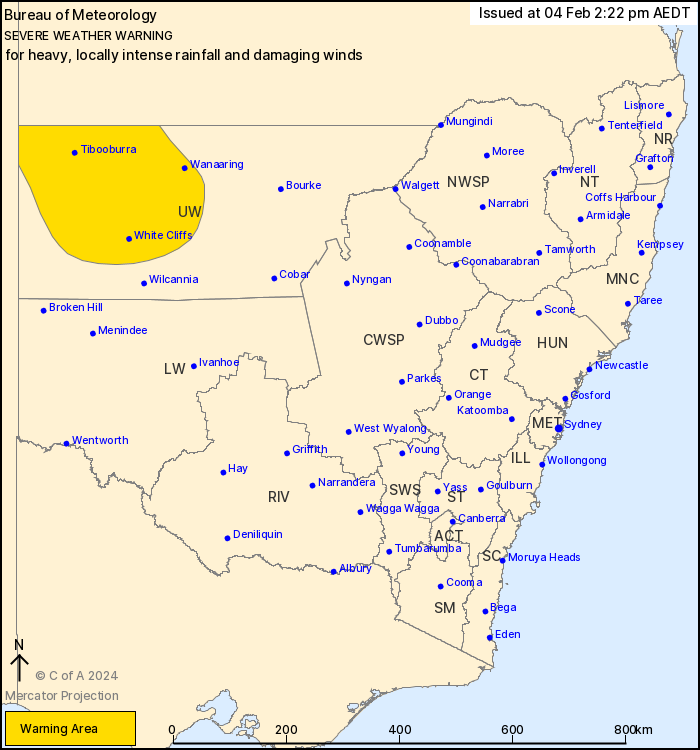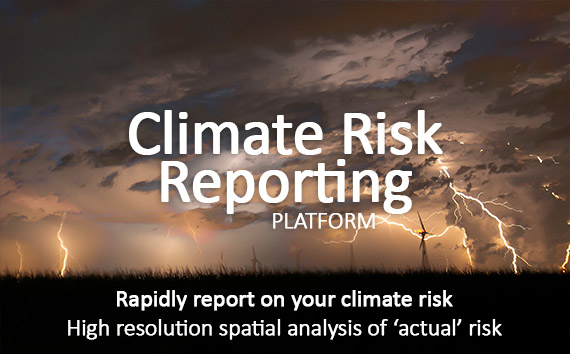Source: Bureau of Meteorology
For people in parts of Upper Western Forecast District.
Issued at 2:22 pm Sunday, 4 February 2024.
HEAVY, LOCALLY INTENSE RAINFALL AND DAMAGING WIND GUSTS DEVELOPING
OVER THE NORTHWEST EARLY MONDAY.
Weather Situation: Ex-Tropical Cyclone Kirrily is currently
positioned over the southwestern corner of Queensland, near the
Northern Territory border. The system is tracking south-southeast
and expecting to move into the Upper Western district early Monday
morning, before heading further southeast into central parts of New
South Wales during Monday evening. The system and its associated
severe weather are expected to clear New South Wales entirely by
Tuesday afternoon.
HEAVY RAINFALL which may lead to FLASH FLOODING is expected in
western parts of the Upper Western district during Monday morning
and afternoon. Six-hourly rainfall totals between 50 and 80 mm are
likely and 24-hourly totals between 70 and 100 mm are
possible.
Locally INTENSE RAINFALL which may lead to DANGEROUS AND
LIFE-THREATENING FLASH FLOODING is also possible close to the low,
particularly on the southern side of the system. Isolated
six-hourly totals between 80 and 120 mm are possible with 24-hourly
totals up to 150 mm. A separate Severe Thunderstorm Warning will be
issued if VERY DANGEROUS THUNDERSTORMS with INTENSE RAINFALL are
detected.
DAMAGING WIND GUSTS in excess of 90 km/h are also possible,
particularly on the eastern side of the system and in thunderstorms
in the warning area.
A Flood Watch is also current for the Upper Western catchments.
See http://www.bom.gov.au/nsw/warnings/ for more information.
Locations which may be affected include Tibooburra, White Cliffs,
Wanaaring and Milparinka.
The State Emergency Service advises that people should:
* Don't drive, ride or walk through flood water.
* Keep clear of creeks and storm drains.
* If you are trapped by flash flooding, seek refuge in the highest
available place and ring 000 if you need rescue.
* Be aware that run-off from rainfall in fire affected areas may
behave differently and be more rapid. It may also contain debris
such as ash, soil, trees and rocks.
* After bushfires, heavy rain and the loss of foliage can make the
ground soft and heavy, leading to a greater chance of
landslides.
* Move vehicles under cover or away from trees.
* Secure or put away loose items around your house, yard and
balcony.
* Keep at least 8 metres away from fallen power lines or objects
that may be energised, such as fences.
* Trees that have been damaged by fire are likely to be more
unstable and more likely to fall.
* Report fallen power lines to either Ausgrid (131 388), Endeavour
Energy (131 003), Essential Energy (132 080) or Evoenergy (131 093)
as shown on your power bill.
* Stay vigilant and monitor conditions. Note that the landscape
may have changed following bushfires.
* For emergency help in floods and storms, ring your local SES
Unit on 132 500.

04/Feb/2024 03:36 AM



